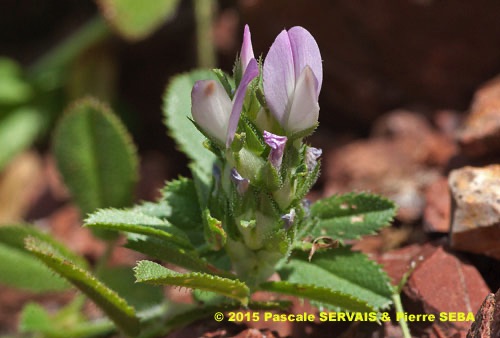
Ononis mitissima L.
Fam. : Fabaceae
© Pascale SERVAIS & Pierre SEBA, 2018. Tilo Botanica: Flore de Tilos et du Dodécanèse / Flora of Tilos and of the Dodecanese
English translation by Brenda Bradbury, Howard Bradbury and Stéphane Léonard
Plante herbacée, hermaphrodite, à tiges étalées à érigées, velues, couvertes de poils glanduleux, ramifiées, cylindriques, non épineuses, de ± 2 mm de diamètre.
Feuilles alternes, composées trifoliées, de 2 à 4 cm de long, à folioles poilues, dentées, la terminale à pétiole très court. 2 stipules membraneuses blanc jaunâtre, veinées de vert, à base blanchâtre, entières, rapprochées en gaine embrassante, plus courtes que le pétiole. Les feuilles proches des fleurs sont réduites à une seule foliole obovale.
Fleurs à symétrie bilatérale, blanc rose, veinées de rose plus foncé, de 10 à 12 mm de long, réunies en grappes spiciformes serrées de 15 à 20 mm de long, portées par un pédoncule très court non aristé. Corolle papilionacée à étendard glabre, nettement plus longue que le tube du calice. Calice à 5 sépales soudés, poilus, de moins de 9,5 mm de long, à tube jaunâtre verdâtre, à dents pointues. Ovaire supère.
Fruits, gousses égalant le calice, ovoïdes, poilues, de 5 à 6 mm de long, à 3 ou 4 petites graines tuberculeuses.
___________________________
Plant herbaceous, hermaphrodite. Stems spread out to erect, very hairy, covered in glandulous hairs, branched, cylindrical, nonspiny, ± 2 mm in diameter.
Leaves alternate, compound trifoliate, from 2 to 4 cm long, with hairy, toothed leaflets, the terminal one with very short petiole. 2 stipules membranous, yellowish white, with green veins, with whitish base, entire, brought closer in clasping sheaths, shorter than the petiole. The leaves near the flowers are reduced to only one obovate leaflet.
Flowers bilaterally symmetrical, pink white, with darker pink veins, from 10 to 12 mm long, joined together in tight spiciform racemes from 15 to 20 mm long, carried by a nonaristate very short peduncle. Corolla papilionaceous with glabrous standard, definitely longer than the tube of the calyx. Calyx with 5 fused, hairy sepals, less than 9.5 mm long, with yellowish greenish tube, with pointed teeth. Ovary superior.
Fruits, ovoid, hairy pods equalling the calyx, from 5 to 6 mm long, with 3 or 4 small, tuberculate seeds.
Descripteurs / Identifying features
1
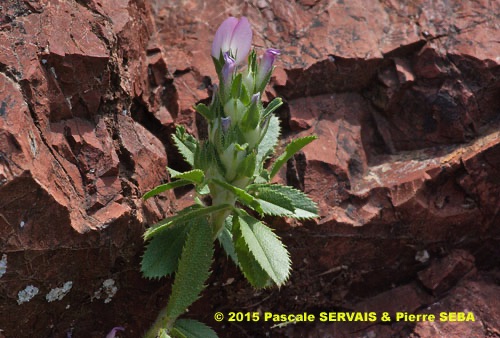
2
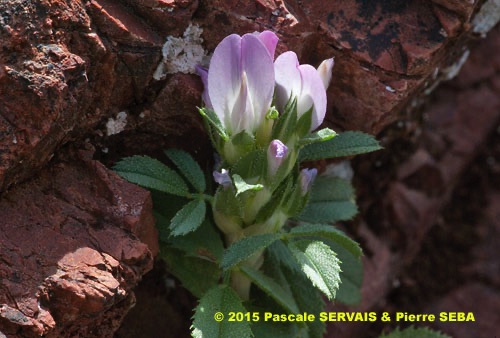
3
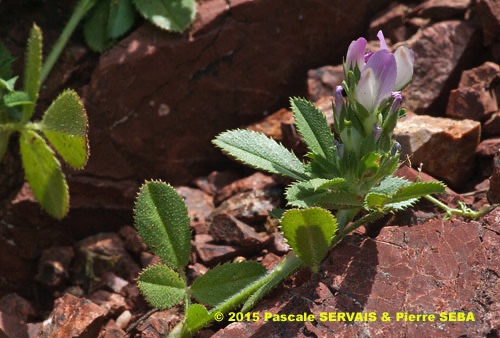
4
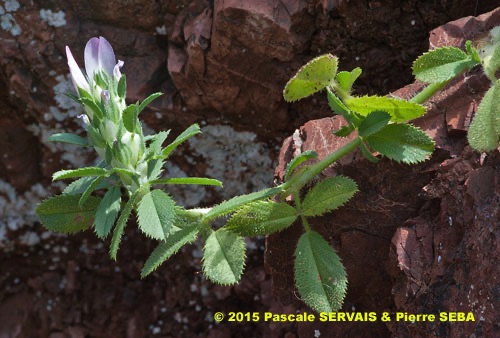
5
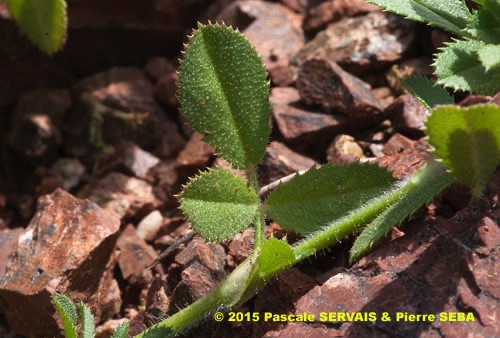
6
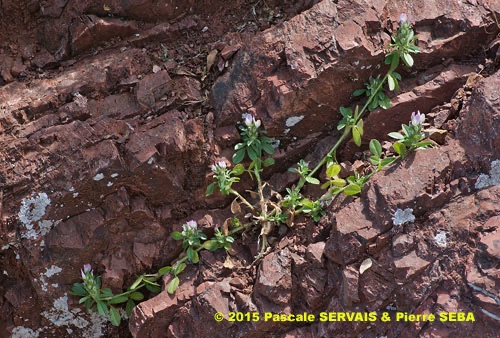
7
Étymologie / Etymology :
Ononis : emprunt du grec ancien ὄνωνις, -ιδος (nom)
[ < ὄνος, -ου (nom) = l’âne + ὀνίς, -ίδος (nom) = la crotte d’âne ],
nom donné à une plante odorante par Théophraste, philosophe
péripatéticien, disciple d’Aristote, botaniste et naturaliste, mort
vers 288 av. J.-C., en référence à l’odeur fétide de certaines espèces.
Mitissima : emprunt du latin mitissimus, -a, -um (superl.)
[ < mitis, -is, -e (adj.) = doux, tendre ] = très doux, très tendre,
en référence à ses tiges sans épines.
Ononis : borrowed from Classical Greek ὄνωνις, -ιδος (noun)
[ < ὄνος, -ου (noun) = donkey + ὀνίς, -ίδος (noun) = donkey
droppings ], name given to an odorous plant by Theophrastus,
peripatetic philosopher, disciple of Aristotle, botanist and naturalist,
died towards 288 BC, referring to the stinking odour of some species.
Mitissima : borrowed from Latin mitissimus, -a, -um (superl)
[ < mitis, -is, -e (adj) = soft, tender ] = very soft, very tender,
referring to its stems without thorns.
Synonymes / Synonyms :
Anonis scariosa Moench
Bugranopsis mitissima (L.) Pomel
Ononis bracteata Pourr.
Ononis mitissima var. campanulata J.J.Rodr.
Ononis spicata Gaterau
Noms vernaculaires / Common names :
Nom français / French name :
Bugrane sans épines.
Nom anglais / English name :
Mediterranean restharrow.
Nom allemand / German name :
Mittelmeer-Hauhechel.
Nom italien / Italian name :
Ononide senza spine.
Habitat :
Cultures - Lieux pierreux - Lieux incultes -
Lieux humides, mares - Chemins - Murs, rochers.
Cultivated places - Stony places - Waste ground -
Damp places, ponds - Waysides - Walls, rocks.
Île / Island :
Tilos.
Hauteur / Height range :
De 10 cm à 50 cm.
From 10 cm to 50 cm.
Floraison / Flowering time :
D’avril à juin.
From April to June.
Groupe / Classification :
Dicotylédones.
Dicotyledons.
Pérennité / Lifespan :
Annuelle.
Annual.
Description :
Clés dichotomiques et descripteurs distinctifs des 6 espèces / Dichotomous keys and distinctive identifying features of the 6 species
Photo 1 :
Localisation / Location : Tilos, Livadia, Pano Meri
Date : 17/05/2015
GPS : Lat. 36,39759° N / Long. 27,40073° E / Alt. 270 m
Type : Photographie numérique / Digital Photograph (10 mégapixels)
Photo 2 :
Localisation / Location : Tilos, Livadia, Pano Meri
Date : 17/05/2015
GPS : Lat. 36,39759° N / Long. 27,40073° E / Alt. 270 m
Type : Photographie numérique / Digital Photograph (10 mégapixels)
Photo 3 :
Localisation / Location : Tilos, Livadia, Pano Meri
Date : 17/05/2015
GPS : Lat. 36,39759° N / Long. 27,40073° E / Alt. 270 m
Type : Photographie numérique / Digital Photograph (10 mégapixels)
Photo 4 :
Localisation / Location : Tilos, Livadia, Pano Meri
Date : 17/05/2015
GPS : Lat. 36,39759° N / Long. 27,40073° E / Alt. 270 m
Type : Photographie numérique / Digital Photograph (10 mégapixels)
Photo 5 :
Localisation / Location : Tilos, Livadia, Pano Meri
Date : 17/05/2015
GPS : Lat. 36,39759° N / Long. 27,40073° E / Alt. 270 m
Type : Photographie numérique / Digital Photograph (10 mégapixels)
Photo 6 :
Localisation / Location : Tilos, Livadia, Pano Meri
Date : 17/05/2015
GPS : Lat. 36,39759° N / Long. 27,40073° E / Alt. 270 m
Type : Photographie numérique / Digital Photograph (10 mégapixels)
Photo 7 :
Localisation / Location : Tilos, Livadia, Pano Meri
Date : 17/05/2015
GPS : Lat. 36,39759° N / Long. 27,40073° E / Alt. 270 m
Type : Photographie numérique / Digital Photograph (10 mégapixels)

Google Maps
Google Maps
Google Maps
Google Maps
Google Maps
Google Maps
Google Maps